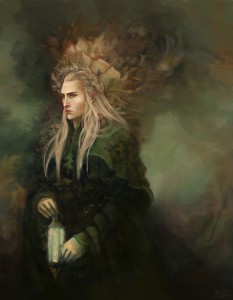 In our latest Library piece, TORn feature writer Tedoras delves deep into J.R.R. Tolkien’s Unfinished Tales of Númenor and Middle-earth to examine what we really know about Thranduil, the Sindarin lord of Mirkwood — a realm largely populated by Silvan elves. How does this make him different? What were the big influences in his political vision for his people? What, in essence, makes him tick?
In our latest Library piece, TORn feature writer Tedoras delves deep into J.R.R. Tolkien’s Unfinished Tales of Númenor and Middle-earth to examine what we really know about Thranduil, the Sindarin lord of Mirkwood — a realm largely populated by Silvan elves. How does this make him different? What were the big influences in his political vision for his people? What, in essence, makes him tick?
It’s good stuff, and inadvertently, it’s almost a companion piece to my own musings on Thranduil’s strongest character traits from earlier this year.
Enjoy!
The many faces of Thranduil
By Tedoras

While Thranduil plays an important (albeit small) role in the contemporary events of The Hobbit, his part in The Desolation of Smaug has been expanded, and we can expect to see more of him in the third and final installment. However, if we wish to understand how Thranduil will affect the future course of Thorin and Company’s quest, we must first look to his past.
Well, what is it that we already know about Thranduil? He is, of course, the King of the Wood-elves of Greenwood the Great, son of Oropher, and father of Legolas. Yet there is far more to his kingship than mere titles. Thranduil is descended from the line of the Sindar, or Grey Elves; yet the population over which he rules in Mirkwood is Silvan (the so-called Wood-elves).
The mingling of these two peoples began in the beginning of the Second Age, when some of the Sindar elected not to leave Middle-earth, and so migrated eastward. It is said that under the Sindar, the Silvan elves “became again ordered folk and increased in wisdom” (UT 269). While it is hard to imagine any clan or line of elves as less than ideal, given the characteristics we as fans attribute to them (and, doubtless, inflate, too), Tolkien makes clear that there is a divarication. [Ed: this is a word, it means “divergence”, or “split”.]
The Silvan of Mirkwood are, if not a lesser line, then a more distantly-sundered one in terms of culture, more firmly fixed in Middle-earth than their counterparts, who would seek to journey to the West. In this distinction of favor, that of the veritable earth versus the evanescent haven, we find the decline, the relegation of the Wood-elves to a lower status among elves, in perception only if in nothing else. But it is a concrete difference, culturally-ingrained and reinforced, and necessary to understand the ruling dynamic between Thranduil and his host.
Now, originally, the realm controlled by Oropher, Thranduil’s father, extended further south and east. But, in the Second Age, he made the decision to withdraw north of the Gladden Fields, in order “to be free from the power and encroachments of the Dwarves of Moria” (UT 270). While here we may see the roots of the enmity and distrust harbored by the elves of the Woodland Realm for the Line of Durin, it should be noted that Oropher also withdrew north in order to distance himself from the intrusion of Galadriel and Celeborn into his lands.

Thranduil would preserve secrecy and doubt over all else; even, as it appears, if it meant his people would have to struggle against encroachment themselves. Indeed, it was ultimately Galadriel and her folk that cleansed Dol Guldur, not the Wood-elves.
Despite the image his reserved and secretive nature conjures up, Thranduil, we cannot forget, was a valiant warrior. Thranduil fought alongside his father and their Silvan host in the Battle of Dagorlad as part of the Last Alliance. And, while Oropher was slain somewhere between the Dead Marshes and the Morannon, Thranduil survived the battle.
Though Thranduil was crowned king upon his return, he noted the terrible loss his people had suffered (“he led back home barely a third of the army,” UT 271). It is perhaps this horrible experience of loss and death in battle that further pushed Thranduil to shelter his people in the fastness of the Greenwood, to further prevent involvement in such matters, since he knows the cost of war too well.
Thus, while we do see Thranduil’s folk come to war in the Battle of Five Armies, I believe we must consider this a rather calculated decision by a prudent lord not rash to throw his people into disarray and death. His motivation for war (be it insufferable enmity or avarice — though I do find these motivators unbecoming of Thranduil in either case) must have, indeed, been great.


